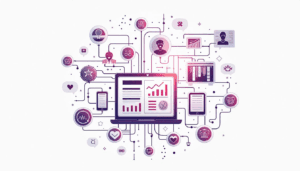What is Psychometric Profiling for B2B Marketing?
10 Feb 2022 By: Jeremy Ambrose
Updated
Target market analysis should be the main driver for all B2B marketing strategies. Whether your business provides software for Book of Ra-technology revolutionizing business or helps small businesses advertise on LinkedIn, getting to know your customers is the key to success.
If you are aware of what influences customers’ decisions, you can get them to work with you instead of your competitors. So how can you reach that goal of increased conversions? By understanding your customer better. One of the most effective ways of doing that is by using psychometric profiling.

Here’s a closer look at how it works in B2B marketing:
What Exactly Is Psychometric Profiling
In a nutshell, psychometric profiling’s primary function is to measure your potential client’s personality. It’s a tool that’s used in B2C marketing to create highly personalized shopping experiences. But you can also use the findings from psychometric profiling in B2B marketing to create super-targeted marketing campaigns. And the cool thing is that most companies don’t mind sharing information about their preferences if it helps to make your product or service a better fit for their needs. Psychometric profiling achieves that goal by diversely categorizing the target audience.
What is the Psychometric Profiling Process?
The psychometric profiling process involves collecting data through surveys, psychometric testing, and analyzing online behavior. This data is then evaluated to create detailed profiles of your target market, focusing on personality traits, values, beliefs, lifestyle, and interests. This allows for a comprehensive understanding of the companies you’re targeting.
Development and Science Behind Psychometric Assessment
Psychometric profiling is based on psychological and behavioral analysis that provides insights into the personalities and preferences of your target audience. It leverages scientific methods to gather data, which allows businesses to create more accurate and targeted B2B marketing campaigns.
Five Things to Measure
Psychometric profiling measures five things that give you a deeper understanding of what makes the people in the client’s company tick. Knowing what fuels a business and its teams enable you to create the best B2B marketing campaigns. Here are the five measures:
- Personality. How does the brand present itself to its audience? Are they fun and cheerful or reserved and serious? It gives you an idea of how to approach them.
- Values. What are the things your target companies stand for? If you don’t align with their values, you have little chance of doing business with them.
- Beliefs. What are the beliefs that the company holds about its industry and its future? You can gain attention to your B2B content marketing by addressing those beliefs directly. For example, an innovative logistics company might believe that by 2030, autonomous vehicles will replace trucks. If you write an engaging article about the topic, you know they’ll read it.
- General lifestyle choices. What is the work culture in your target companies? What are the values they cherish? Are they family-oriented, do they prioritize their careers, or are social justice issues important to them?
- Interests. Where does the company see itself in ten years? Are there plans of taking their local business to another continent? Is there development to manufacture an additional product? You can use answers to these questions in your next ad campaign.

How to Find the Data
So how can you find all the necessary data? It’s simple. First, companies use social media just like individuals. They tweet, write Facebook posts, upload Instagram pictures, etc. You can get plenty of B2B marketing ideas simply by studying the online behavior of companies you want to reach.
You can also turn to Social Media Intelligence (SOCMINT). It means technologies and techniques that enable you to scan social media content. For example, the Facebook Page Barometer is a service that hands out statistics about Facebook pages. Secondly, you can analyze your emails’ open rate via tracking tools like Mailtrack and SalesHandy. Try to get to the bottom of which headlines work the best and why.
And let’s not forget the third option: buying the information from organizations that gather large amounts of data. From the department of motor vehicles offices, for example.
Understanding Customers’ Intention
Psychometric profiling helps you discover why companies buy your products and services. Maybe they purchase your software to try something new, to get the bonus promised in the offer, or because of influencer promotion, etc. Based on the intent, you can divide your customers into subgroups. And then assign a personality type for each group.
You can then take a look at your own sales funnel. What’s the point where you’re losing the most customers? Is there something at this point that goes against the personality of your target audience? Maybe your ad texts communicate values that they don’t appreciate. Or maybe, the slow loading of your page scares off companies who value efficiency. Fixing these problems leads to lower shopping cart abandonment rates and more conversions.
Reach More Specific Audiences on Social Media With Your B2B Marketing
Psychometric profiling lets you get super specific with your social media ad targeting. It allows you to craft messages that are in line with the core beliefs of your customers to draw in more followers organically. For example, if the companies in your target audience are environment-friendly, you can position your products as made via eco-friendly methods (given that they are).
The thing is that people are loyal to brands that share their values. And psychometric profiling allows you to identify your most loyal clients and profile them based on the five measures (personality, values, beliefs, general lifestyle choices, interests). Then you can make sure your brand communicates what your clients like to see.
Psychometric Profiling: How to Use It
Here are three ways psychometric profiling helps your B2B marketing efforts:
- New Content Ideas From Psychometric Profiling
The thing is that people are loyal to brands that share their values. And psychometric profiling allows you to identify your most loyal clients. Then you can make sure your brand communicates what they like to see.
- Write Better Emails
Knowing who your customers are, allows you to create more engaging emails. Use B2B email marketing automation tools like ActiveCampaign or Benchmark to send out the emails at times they’ll get opened most likely.
- Make Your Ads More Relevant
Using the profiles, you can now improve the relevancy of your ads. Show them ads that reflect their lifestyle choices.
Psychometric profiling tells you who your customers are, why they behave in a certain way, and what kind of personalities they have. You can use this information together with B2B marketing case studies to influence the prospects’ buying decisions and gain their loyalty. Which business wouldn’t want that?
Do you plan to use psychometric profiling in your B2B marketing plan this year? Let us know in the comments.


